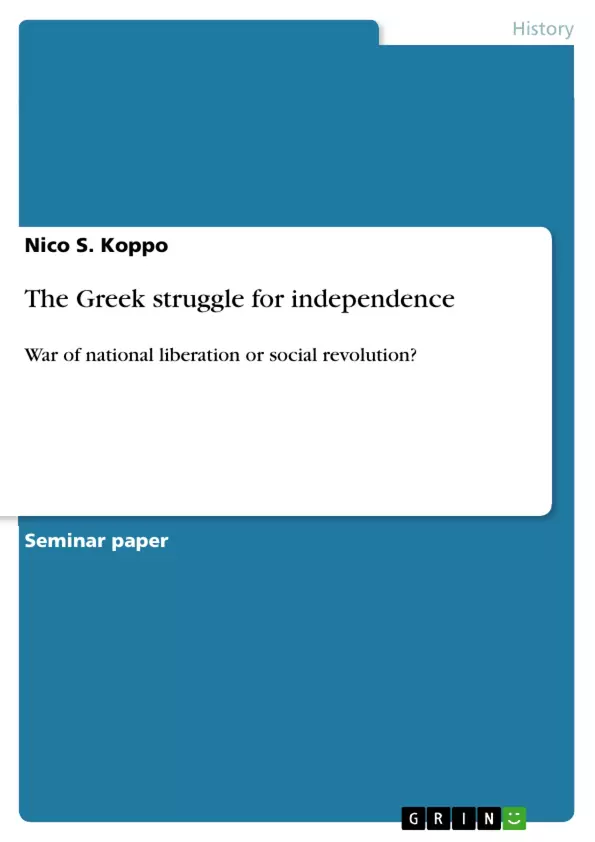Armed uprisings, revolutions or civil wars do not come out of the blue. But what were the main reasons of the Greek war of independence? Some scholars have tried to explain this event as a war of national liberation, driven by a strong national identity amongst the Greek population. This essay intends to challenge such explanatory models by exploring the very diversity and heterogeneity of the several social groups within the movement for an independent Greek nation state.
Table of Contents
- Introduction
- The Ottoman Empire at the dawn of the nineteenth century
- The social structure of the Greek population
- The Orthodox Church
- The Phanariots
- The wealthy landowners and notables
- The Greek bourgeoisie
- The peasantry in the Balkan Peninsula
- The Greek intelligentsia in the Exile
- Conclusion
Objectives and Key Themes
This essay aims to challenge the prevailing narrative of the Greek War of Independence as a purely national liberation struggle. Instead, it seeks to illuminate the diverse and heterogeneous social groups involved, highlighting their varied motivations and intentions. The analysis focuses on the constellation of economic, social, and political forces within the Greek community and their sometimes contradictory goals.
- The social and economic structure of the Greek population under Ottoman rule.
- The diverse motivations of various Greek social groups in the struggle for independence.
- The internal conflicts and divisions within the Greek movement.
- The role of the Ottoman Empire's internal structure in contributing to the conflict.
- An alternative interpretation of the Greek War of Independence beyond a simplistic narrative of national liberation.
Chapter Summaries
Introduction: This introductory chapter sets the stage for the essay by challenging the conventional understanding of the Greek War of Independence as a unified national liberation struggle. It highlights the controversy surrounding the event and proposes an alternative perspective that emphasizes the diverse social groups involved and their conflicting aims. The author intends to explore these internal divisions and their impact on the course of the war, rather than providing a chronological narrative of events. The exclusion of external factors like the influence of European powers and Philhellenism is acknowledged, yet their significance is implied for future consideration.
The Ottoman Empire at the dawn of the nineteenth century: This chapter provides an overview of the Ottoman Empire at the turn of the 18th to the 19th century. It describes the empire's hierarchical and feudal structure, centered on the authority of the sultan. The chapter emphasizes the failure of internal reforms, particularly the weakening of the timar system (the land-based military and economic backbone of the empire), as a major contributing factor to the empire's decline and internal instability. This sets the context for understanding the conflicts within the Greek population and their relationship to the weakening Ottoman state. The chapter also hints at the external pressures faced by the Ottoman Empire from rising European powers, further complicating the internal dynamics.
Keywords
Greek War of Independence, Ottoman Empire, social structure, national identity, internal conflict, social revolution, national liberation, heterogeneity, feudalism, timar system.
Frequently Asked Questions: A Comprehensive Language Preview
What is the main topic of this essay?
The essay challenges the traditional view of the Greek War of Independence as a unified national liberation struggle. It instead focuses on the diverse social groups involved, their varied motivations, and the internal conflicts within the Greek movement itself.
What are the key themes explored in the essay?
Key themes include the social and economic structure of the Greek population under Ottoman rule, the diverse motivations of different Greek social groups, internal conflicts and divisions within the Greek movement, the role of the Ottoman Empire's internal structure in the conflict, and an alternative interpretation of the Greek War of Independence that moves beyond a simplistic narrative of national liberation.
What social groups are examined in the essay?
The essay examines a range of Greek social groups, including the Orthodox Church, the Phanariots, wealthy landowners and notables, the Greek bourgeoisie, the peasantry in the Balkan Peninsula, and the Greek intelligentsia in exile. The analysis highlights the varied roles and motivations of each group.
What is the role of the Ottoman Empire in the essay?
The essay examines the Ottoman Empire's internal structure, particularly its weakening state at the beginning of the 19th century and the decline of the timar system, as a significant factor contributing to the instability and conflicts within the Greek population. While external pressures from European powers are acknowledged, the focus remains primarily on internal dynamics.
What is the essay's approach to the Greek War of Independence?
The essay adopts a nuanced approach, moving beyond a simplistic narrative of national unity and liberation. It emphasizes the internal divisions, conflicts, and diverse motivations within the Greek community, highlighting the heterogeneity of the movement and its participants.
What is covered in the Introduction chapter?
The introduction sets the stage by challenging the conventional understanding of the war as a unified national struggle. It highlights the controversy surrounding the event and proposes an alternative perspective emphasizing the diverse social groups involved and their conflicting aims. It also previews the essay's focus on internal divisions and their impact on the war's course.
What is covered in the chapter on the Ottoman Empire?
This chapter provides an overview of the Ottoman Empire at the turn of the 18th to 19th centuries, describing its hierarchical and feudal structure and the weakening of the timar system. It emphasizes the empire's internal instability as a contributing factor to the conflicts within the Greek population. External pressures from European powers are also mentioned as a contextual element.
What are the key words associated with this essay?
Key words include: Greek War of Independence, Ottoman Empire, social structure, national identity, internal conflict, social revolution, national liberation, heterogeneity, feudalism, and timar system.
- Quote paper
- Nico S. Koppo (Author), 2002, The Greek struggle for independence, Munich, GRIN Verlag, https://www.grin.com/document/20905



